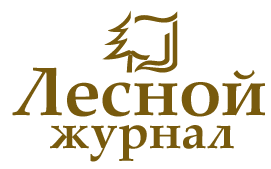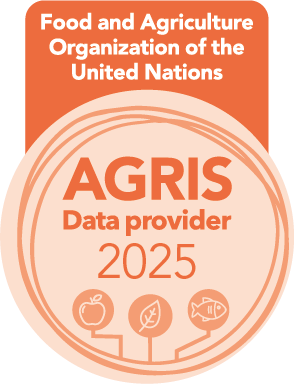

Address: Naberezhnaya Severnoy Dviny, 17, Arkhangelsk, 163002, Russian Federation, Northern (Arctic) Federal University named after M.V.Lomonosov, office 1425
Phone: +7 (8182) 21-61-18
E-mail: forest@narfu.ru
http://lesnoizhurnal.ru/en/
|
Long-Term Testing of Aspen Clones in European Russia. С. 9-19
|
 |
Tsarev V.A., Tsarev A.P., Tsareva R.P., Laur N.V.
UDС
630*232.12
DOI:
10.37482/0536-1036-2025-3-9-19
Abstract
The results of 40 years of testing of more than 20 aspen clones selected in various regions of European Russia and the USSR, growing in the Semiluki Tremuletum in the Voronezh Region, are presented. The survival of plants, growth in height, diameter and volume of the stem are shown. A ranked assessment has been given and a selection of promising clones for the creation of highly productive aspen plantations has been carried out. It has also been noted that sexual dimorphism can have different effects on aspen rot resistance in different growing conditions. The testing has been conducted at the Central Research Institute of Forest Genetics and Breeding (currently the All-Russian Research Institute of Forest Genetics, Breeding and Biotechnology). A number of employees of the Institute have been engaged in the selection of the best forms, and then in hybridization, since its organization in 1971. The aim of this study has been to investigate the survival and growth of 21 long-lived aspen clones, as well as their productivity (in terms of stem volume), growing in the Semiluki Tremuletum of the Voronezh Region. It has been revealed that the height variation at the age of 40 has been quite wide – from 17.3 to 31.3 m, diameters – from 28.0 to 50.0 cm, stem volumes – from 0.3 to 2.4 m3. The top 5 has included 2 aspen clones from the Botanical Garden of the Voronezh State University (clones no. 16 and 17), 2 hybrids introduced from the Baltic States (clones no. 20, 23) and American aspen (clone no. 29). Their average height at the age of 40 has been 26–31 m, diameter – 42–50 cm, stem volume – 1.4–2.4 m3. This indicates the possibility of selecting promising aspen clones for their further propagation and introduction into plantation forest cultivation. At the same time, male clones (Pzg hybrid and American aspen clone no. 29), also introduced from the Baltic States, can be recommended for landscaping.
Authors
Vadim A. Tsarev1, Candidate of Agriculture, Assoс. Prof.; ResearcherID: ABE-5600-2020,
ORCID: https://orcid.org/0000-0002-3921-9339
Anatoly P. Tsarev1*, Doctor of Agriculture, Prof.; ResearcherID: S-6639-2019,
ORCID: https://orcid.org/0000-0001-8019-0016
Raisa P. Tsareva1, Candidate of Agriculture, Senior Research Scientist;
ResearcherID: AAK-2110-2021, ORCID: https://orcid.org/0000-0002-6949-4665
Natal’ya V. Laur2, Doctor of Agriculture, Assoс. Prof.; ResearcherID: AAL-1770-2021,
ORCID: https://orcid.org/0009-0007-5733-1379
Affiliation
1All-Russian Research Institute of Forest Genetics, Breeding and Biotechnology, ul. Lomonosova, 105, Voronezh, 394087, Russian Federation; vad.tsareff@yandex.ru, antsa-55@yandex.ru, tsarais42@mail.ru
2Petrozavodsk State University, prosp. Lenina, 33, Petrozavodsk, 185910, Russian Federation; laur@petrsu.ru
Keywordstremuletum, aspen, clones, hybrids, variety testing, ranking, growth and productivity analysis, sexual dimorphism, selection
References
- Bagaev E.S., Chudetsky A.I., Makarov S.S. Evaluation of the Possibility of the Use of Fast-Growing Aspen Forms for Laying Timber Plantations with a Short Turnover of Felling. Lesokhozyajstvennaya informatsiya = Forestry information, 2023, no. 1, pp. 55–67. (In Russ.). https://doi.org/10.24419/LHI.2304-3083.2023.1.05
- Bagaev S.N., Korenev I.A., Bagaev S.S., Zontikov D.N. Features of the Formation of Fast-Growing Clones in the Genetic Reserve of Giant Aspen. Lesnoe khozyajstvo, 2013, no. 2, pp. 26–28. (In Russ.).
- Bagaev E.S. Prospects for the Use of Fast-Growing Aspen Forms for the Establishment of Forest Raw Material Plantations. Aktual’nye problemy nauki v agropromyshlennom komplekse: Collection of Articles from the 69th International Scientific and Practical conference in 3 vol. Ed. by Yu.V. Pankratov, N.Yu. Paramonova. Karavaevo, Kostroma State Agricultural Academy, 2018, vol. 1, pp. 6–10. (In Russ.).
- Boytsov A.K., Zhigunov A.V., Lukina A.D., Babich A.I. Dynamics of Preservation of Hybrid Aspen Clones in Crops in the North-West of Russia. Lesa Rossii: Politika, Promyshlennost’, Nauka, Obrazovanie: Proceedings of the 7th All-Russian Scientific and Technical Conference. St. Petersburg, Saint-Petersburg State Forest Technical University, 2022, pp. 68–71. (In Russ.).
- Boytsov A.K., Zhigunov A.V. Ten-Year Breeding Tests for Growing Clones of Hybrid Aspen and Other Hybrid Poplars in the Conditions of the North–West of Russia. Trudy Sankt-Peterburgskogo nauchno-issledovatel’skogo instituta lesnogo khozyajstva = Proceedings of the Saint Petersburg Forestry Research Institute, 2023. no. 3, pp. 38–52. (In Russ.). https://doi.org/10.21178/2079-6080.2023.3.38
- Chernishenko O.V., Rumyantsev D.E., Sarapkina E.V. The Problem of the Growing and Breeding of Healthy Aspen at the Present Time. Resources & Technology, 2016, vol. 13, no. 4, pp. 1–11. (In Russ.). https://doi.org/10.15393/j2.art.2016.3421
- Dincă L., Vechiu E. The Aspen (Populus tremula L.) from the Southern Carpathians. Current Trends in Natural Sciences, 2020, vol. 9, iss. 17, pp. 168–174. https://doi.org/10.47068/ctns.2020.v9i17.020
- Fedorkov A.L. Stem Volume and Quality of Hybrid and Common Aspen in the Clonal Archive. Lesnoy Zhurnal = Russian Forestry Journal, 2021, no. 1, pp. 92–98. (In Russ.). https://doi.org/10.37482/0536-1036-2021-1-92-98
- Hadži-Georgiev K., Goguŝevski M. Dvolazne Tabele Mass za Topola Klona Populus euramericana cv. I-214 u Gevgeliskom Području. Topola, 1972, vol. XVI, no. 90, pp. 25–29. (In Serb.-Croat.).
- Kivinen S., Koivisto E., Keski-Saari S., Poikolainen L., Tanhuanpää T., Kuzmin A., Viinikka A., Heikkinen R.K., Pykälä J., Virkkala R., Vihervaara P., Kumpula T. A Keystone Species, European Aspen (Populus tremula L.), in Boreal Forests: Ecological Role, Knowledge Needs and Mapping Using Remote Sensing. Forest Ecology and Management, 2020, vol. 462, art. no. 118008. https://doi.org/10.1016/j.foreco.2020.118008
- Kusbach A., Hruban R. Osika: Všudybylka, Popelka a Buřeň Kulturních Lesů? Lesnická Práce, 2020, no. 4, pp. 120–122. (In Czech).
- Kusbach A., Šebesta J., Hruban R., Peška P., Rogers P.C. Eurasian Aspen (Populus tremula L.): Central Europe’s Keystone Species ‘Hiding in Plain Sight’. PLOS ONE, 2024, no. 19 (3), art. no. e0301109. https://doi.org/10.1371/journal.pone.0301109
- Liesebach M. Poplars and Other Fast–Growing Tree Species in Germany: Report of the National Poplar Commission. Progress Report 2016–2019. Germany, Braunschweig, Thünen Working Paper 141a, 2020. 33 p. https://doi.org/10.3220/WP1585727785000
- Meyer M., Gebauer K., Janssen A., Krabel D. The Importance of Fuel Characteristics of Poplars and Aspens (Populus spp.) from German Short Rotation Plantations and Russian Forests. German Russian Conference on Forest Genetics – Proceedings – Ahrensburg, 2017 21–23 November. Degen B., Krutovsky K.V., Liesebach M. (eds). Germany, Braunschweig, Thünen Report 62, 2018, pp. 61–66. https://doi.org/10.3220/REP1539855736000
- Myking T., Bøhler F., Austrheim G., Solberg E.J. Life History Strategies of Aspen (Populus tremula L.) and Browsing Effects: a Literature Review. Forestry: An International Journal of Forest Research, 2011, vol. 84, iss. 1, pp. 61–71. https://doi.org/10.1093/forestry/cpq044
- Petrukhnov V.P. Aspen Hybridization in the Central Chernozem Oblast. Gibridizatsiya lesnykh drevesnykh porod: Collection of Scientific Papers. Voronezh, Central Research Institute of Forest Genetics and Breeding, 1988, pp.101–106. (In Russ.).
- Rogers P.C., Pinno B.D., Šebesta J., Albrectsen B.R., Li G., Ivanova N., Kusbach A., Kuuluvainen T., Landhäusser S.M., Liu H., Myking T., Pulkkinen P., Wen Z., Kulakowski D. A Global View of Aspen: Conservation Science for Widespread Keystone Systems. Global Ecology and Conservation, 2020, vol. 21, art. no. e00828. https://doi.org/10.1016/j.gecco.2019.e00828
- State Forest Register 2013 (as of January 1, 2014). Moscow, Roslesinforg Publ., 2014. 690 p. (In Russ.).
- Tsarev A.P. Growth and Breeding of Aspen in Russia. Silvae Genetica, 2013, vol. 62, iss. 1–6, pp. 153–160. https://doi.org/10.1515/sg-2013-0020
- Tsarev A., Tsareva R., Tsarev V., Fladung M., Wühlisсh G. von. Aspen Hybridization: Parents’ Compatibility and Seedlings’ Growth. Silvae Genetica, 2018, vol. 67, pp. 12–19. https://doi.org/10.2478/sg-2018-0002
- Tsareva R.P. Aspen Breeding. Breeding of Forest and Ornamental Woody Plants. A.P. Tsarev, S.P. Pogiba, N.V. Laur. Ed. by A.P. Tsarev. Moscow, Moscow State Forest University Publ., 2014, pp. 350–363. (In Russ.).
- Turna İ., Atar F. Stand Analysis and Distribution Areas of European Aspen (Populus tremula L.) Forests in Türkiye. SilvaWorld, 2024, vol. 3, no. 1, pp. 15–27. https://doi.org/10.61326/silvaworld.v3i1.148
- Worrell R. European Aspen (Populus tremula L.): A Review with Particular Reference to Scotland. II. Values, Silviculture and Utilization. Forestry, 1995, vol. 68, iss. 3, pp. 231–243. https://doi.org/10.1093/forestry/68.3.231
- Wuehlish G. von. Growth Performance of F1-Hybrids, Backcrossed Hybrids and F2-Hybrids of Populus tremula and Populus tremuloides. Poplars and Willows: from Research Models to Multipurpose Trees for a Bio-Based Society: 5th International Poplar Symposium. Italy, Orvieto, 2010. 37 p.
- Wühlisch G. von. Eurasian aspen – Populus tremula. EUFORGEN: Technical Guidelines for Genetic Conservation and Use. Italy, Rome, Biodiversity International, 2009. Available at: https://www.yumpu.com/en/document/read/22884009/eurasian-aspen-populus-tremula-euforgen (accessed 12.03.24).
- Yablokov A.S. Growing and Breeding Healthy Aspen. Moscow, Goslesbumizdat Publ., 1963. 442 p. (In Russ.).
- Zhigunov A.V., Shabunin D.A., Butenko O.Yu. Triploid Aspen Forest Plantations of in vitro Planting Material. Vestnik Povolzhskogo gosudarstvennogo tekhnologicheskogo universiteta. Seriya “Les. Ekologiya. Prirodopol’zovanie” = Vestnik of Volga State University of Tecnology. Series “Forest. Ecology. Nature Management”, 2014, no. 4 (24), pp. 21–30. (In Russ.).
- Zhigunov A.V., Ulianich P.S., Lebedeva M.V., Potokina E.K. Development of Research Resources for Marker-Assisted Selection of Aspen (Populus tremula L.) in Russia. German Russian Conference on Forest Genetics – Proceedings – Ahrensburg, 2017 21-23 November. Degen B., Krutovsky K.V., Liesebach M. (eds). Germany, Braunschweig, Thünen Report 62, 2018, pp 35–39. https://doi.org/10.3220/REP1539855736000
- Zontikov D.N., Zontikova S.A., Bagayev E.S., Bagayev S.S., Sergeyev R.V., Novikov P.S., Shurgin A.I. Growth and Productivity of Populus tremula L. in the Kostroma Region. Scientific Journal of KubSAU, 2013, no. 91 (07), pp. 311–321. (In Russ.).
|
Make a Submission


Lesnoy Zhurnal (Russian Forestry Journal) was awarded the "Seal of Recognition for Active Data Provider of the Year 2025"

|







